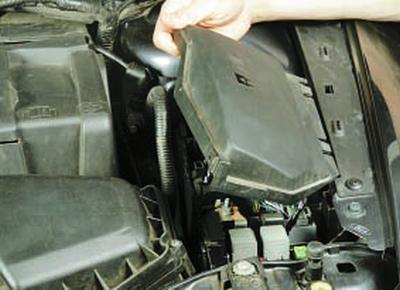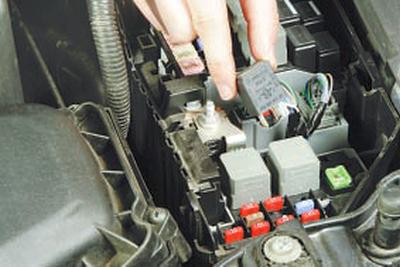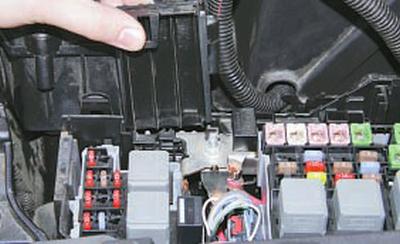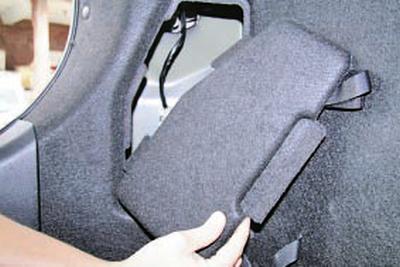
Pic. 10.1. Location of fuses and relays in the mounting block installed in the engine compartment (view from above).

Pic. 10.2. Location of fuses and relays in the mounting block installed in the engine compartment (side view, protective fuse covers removed).

Pic. 10.3. The location of the fuses in the central mounting block located in the cabin.

Pic. 10.4. The location of the fuses in the rear mounting block installed in the luggage compartment of cars with sedan and hatchback bodies.

Pic. 10.5. The location of the fuses in the rear mounting block installed in the luggage compartment of station wagons.
Most vehicle electrical power circuits are protected by fuses. Headlights, fan motors, fuel pump and other powerful consumers are connected via relays.
Fuses and relays are installed in mounting blocks located in the passenger compartment and engine compartment.
Most fuses and relays are installed in the fuse and relay box (pic. 10.1 and 10.2), located in the engine compartment on the left side, near the battery and air filter. The purpose of the fuses and relays is given in Table. 10.1.


NOTES: 10.1 and 10.2 show the maximum possible set of fuses and relays.
On a particular car, some of them may be missing (depending on vehicle configuration).
In table. 10.1 shows the purpose of only those relays, the replacement of which may be required by the driver in order to ensure traffic safety and maintain health. The rest of the relays in case of malfunctions must be replaced at the service after diagnostics.
Fuses for the lighting system, sound alarm, climate control, etc. are located in the central fuse box mounted on the cover of the GEM multifunctional electronics box (pic. 10.3), which, in turn, is installed under the instrument panel on the right.
The purpose of the fuses is given in table. 10.2.

NOTE: In fig. 10.3 shows the maximum possible set of fuses. On a particular car, some of them may be missing (depending on vehicle configuration).
Fuses for control systems for power windows, locks, exterior mirrors, front seat adjustment mechanisms, parking sensors, etc.
are located in the rear fuse box under the left luggage compartment side trim (pic. 10.4 and 10.5). The purpose of the fuses is given in table. 10.3.

NOTE: In fig. 10.4 and 10.5 show the maximum possible set of fuses. On a particular car, some of them may be missing (depending on vehicle configuration).

The central fuse mounting block is located on the top cover of the multifunctional electronic unit, installed on the right under the instrument panel (under the glove box).
NOTE: Shown with instrument panel removed for clarity.

1. To gain access to the fuses of the central mounting block, turn the lock of the base of the multifunctional electronics box a quarter of a turn to the right, remove the base from the holders and lower it down.
NOTE: For ease of handling the unit, its housing can be pulled out by rearranging the housing protrusions in the slots of the supporting brackets.
After that, access to the central fuse box will open.
2. Before replacing a blown fuse, find out the cause of the blown fuse and fix it. When looking for a malfunction, look at the ones listed in Table. 10.2 the circuits that this fuse protects.
WARNING: Do not replace fuses with jumpers or fuses of a different amperage or makeshift jumpers, as this may damage electrical appliances and even cause a fire.

3. Remove the replacement fuse by rocking it slightly from side to side.

NOTE: It is more convenient to remove the fuse with special tweezers installed in a clip on the back of the cover of the mounting block located in the engine compartment.

4. This is what a blown fuse looks like (the jumper shown by the arrow inside the holder has burned out and opened). To replace a fuse, use a spare fuse of the same rating (and colors).

5. To install a new fuse, insert its contacts into the holders of the block and, pressing it from above, drown it all the way.

6. To access the fuses and relays of the mounting block in the engine compartment, press aside the two latches of its cover from one..

7….and on the other hand…

8….and remove the cover.

NOTE: On the inside of the cover of the relay and fuse mounting block located in the engine compartment, there is a diagram of the location of the relay and fuses. Tweezers B are also fixed there to remove the fuses from the mounting blocks, next to it there are sockets A for attaching spare fuses.

9. If replacement is necessary, remove the fusible link..

10….fuse…

11….or a relay by rocking it from side to side.

12. To gain access to the fuses located on the side of the mounting block (see fig. 10.2), wring out the latches of the side protective cover with a screwdriver..

13.... and remove it by sliding it up along the grooves of the block body.

14. Similarly remove the second cover.

15. To replace the fusible insert B, unscrew the two nuts A of its fastening, install a new insert and secure with nuts.

16. To gain access to the rear fuse box, press the hatch cover latch in the upholstery of the left side of the luggage compartment..

17….and remove the cover.

18. Squeezing the latches on the sides of the fuse box covers..

19….remove the top…

20.... and lower blocks.
NOTE: Three mounting blocks may be installed depending on the vehicle configuration. The covers of all blocks are removed in the same way.
21. Replace the blown fuse in the same way as they did for the central mounting block and the block located in the engine compartment (see above in this subsection).
22. Install the parts in the reverse order of removal.
Visitor comments